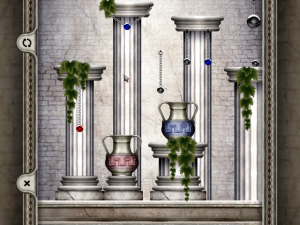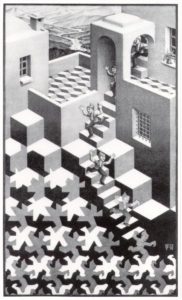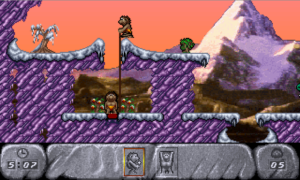Obulis: Finished
It turns out that Obulis makes it completely clear when it thinks you’ve won, announcing it explicitly in a pop-up and then playing a credits sequence. This is a bit of a relief, because I wasn’t entirely clear on which levels were necessary for winning and which were optional bonus levels.
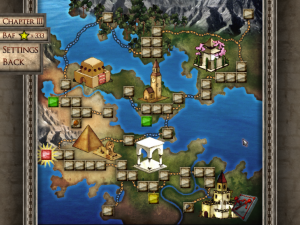 The game is organized into three chapters, each of which contains multiple “paths”, or sequences of themed levels with their own graphical style, background music, and, in some cases, path-specific gameplay elements: Clock Tower levels have steadily-rotating gears that can carry marbles in their teeth, Pond levels are built out of flowering plants that are a little springy and never completely straight, etc. The maps show the individual levels as squares in a sort of board-game layout that visually differentiates between the levels you haven’t reached yet, the levels you’ve completed (which are still available for replay), and, most importantly, the levels you have access to but haven’t completed, which have a jagged nimbus so they really stand out. Paths sometimes branch a little, so that completing one path can open up access to two others. It’s all pretty typical of the superstructure in modern puzzle-games, particularly puzzle games that imagine themselves to be casual. (I personally have doubts whether a puzzle game with designed solutions can ever really fit the “casual” mold, but that takes us to the question of “What is a casual game?”, and that’s not what I want to talk about today.)
The game is organized into three chapters, each of which contains multiple “paths”, or sequences of themed levels with their own graphical style, background music, and, in some cases, path-specific gameplay elements: Clock Tower levels have steadily-rotating gears that can carry marbles in their teeth, Pond levels are built out of flowering plants that are a little springy and never completely straight, etc. The maps show the individual levels as squares in a sort of board-game layout that visually differentiates between the levels you haven’t reached yet, the levels you’ve completed (which are still available for replay), and, most importantly, the levels you have access to but haven’t completed, which have a jagged nimbus so they really stand out. Paths sometimes branch a little, so that completing one path can open up access to two others. It’s all pretty typical of the superstructure in modern puzzle-games, particularly puzzle games that imagine themselves to be casual. (I personally have doubts whether a puzzle game with designed solutions can ever really fit the “casual” mold, but that takes us to the question of “What is a casual game?”, and that’s not what I want to talk about today.)
And occasionally the paths branch into optional bonus levels. Some of these levels are harder variations on levels in the path proper. These are easily identifiable by name: every level has a name consisting of its path name and a roman numeral, like “Dungeon III” or “Windmill VI”, and the harder variants just append the word “Ultra” to the end of that. Ultra levels have the same architecture as the levels they’re based on, and usually have a similar layout of balls, but are altered enough to require completely different solutions. I kind of assumed that these were optional, because they just seemed like extra content for people who want more challenges. (DROD, to name one precedent, has a few rooms that are harder variations on other rooms, and they’re invariably optional.) 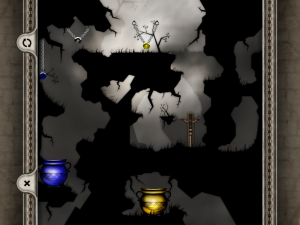 But there was another sort that I wasn’t at all sure about: the Inner Sanctum levels. This is a “path” consisting entirely of single levels reachable from other paths. The unique presentation for these levels is inky silhouettes; the gameplay gimmick is that the silhouettes have paths through them that you can’t see, and have to find by experimentation; the background music, rather incongruously, consists of traffic noises. And each Inner Sanctum level you complete gives you a piece of a special artifact for that map. Each artifact, when completed, unlocks some of the Ultra levels — or were the Ultra levels unlocked by collecting the medallions at the end of the normal paths? I’ve forgotten already. This stuff isn’t where your attention falls while playing.
But there was another sort that I wasn’t at all sure about: the Inner Sanctum levels. This is a “path” consisting entirely of single levels reachable from other paths. The unique presentation for these levels is inky silhouettes; the gameplay gimmick is that the silhouettes have paths through them that you can’t see, and have to find by experimentation; the background music, rather incongruously, consists of traffic noises. And each Inner Sanctum level you complete gives you a piece of a special artifact for that map. Each artifact, when completed, unlocks some of the Ultra levels — or were the Ultra levels unlocked by collecting the medallions at the end of the normal paths? I’ve forgotten already. This stuff isn’t where your attention falls while playing.
At any rate, because I didn’t look at the manual until after winning the game, I wasn’t sure if the Inner Sanctum levels were optional or not. It turns out that they are. I went back and completed them all after winning anyway, and in the process discovered that the game is rather insistent about playing the credits sequence, which isn’t interruptible, every time you complete a level after winning. Ah well. I probably won’t finish all the Ultras: they tend to be challenges of the “get things to collide in midair in just the right way” sort, rather than the “figure out the clever tick that makes it easy” sort. If I even make the attempt, it’ll be for the Achievements. Every single Ultra level has a Steam achievement associated with it.
 Comments(3)
Comments(3)